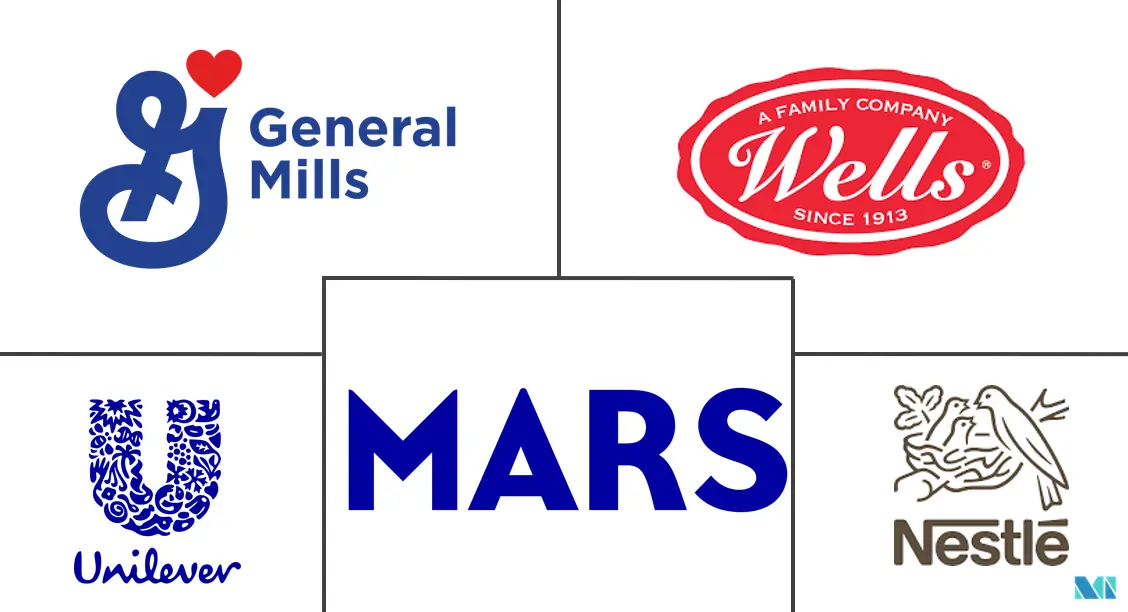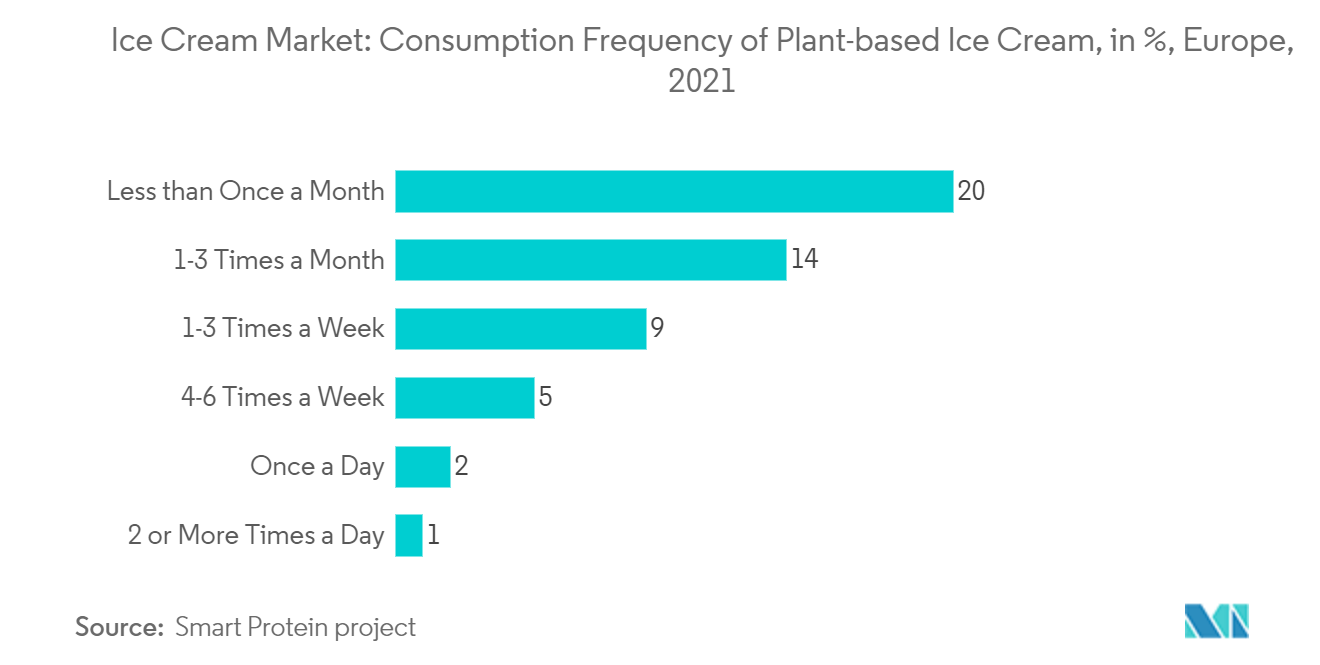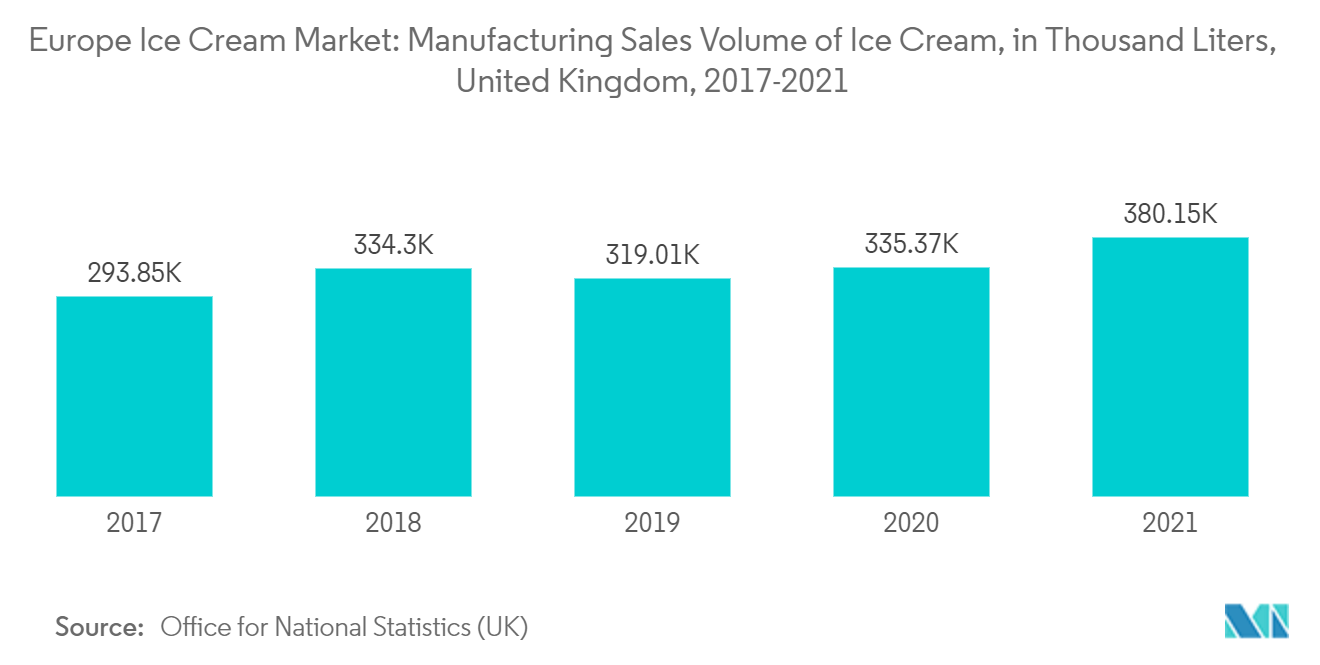Europe Ice Cream Market Size

| Study Period | 2019 - 2029 |
| Base Year For Estimation | 2023 |
| Forecast Data Period | 2024 - 2029 |
| Historical Data Period | 2019 - 2022 |
| CAGR | 4.87 % |
| Market Concentration | Low |
Major Players
*Disclaimer: Major Players sorted in no particular order |
Europe Ice Cream Market Analysis
The European ice cream market is projected to record a CAGR of 4.87% over the upcoming five years.
Demand for ice creams that are low on fats, made using natural ingredients, yet do not compromise on taste and indulgence is growing across Europe. Germany and Russia are the biggest ice cream markets in Europe. Over the medium term, indulgence and the increasing consumer preference for ice cream as a leisure product drove the growth of this market, and new innovative flavors, offered by companies, further act as a catalyst for demand generation.
One of the popular trends in the European ice cream market is the premiumization of ice creams. Europeans prefer premium ice creams due to their distinctive flavors and portions. Premium ice cream has a higher percentage of butterfat and fewer air particles per ice cream particle. The demand for luxury ice cream and regular ice cream desserts is also rising sharply in the European market due to the continent's rapidly expanding urbanization and the dairy industry's improved technological improvements. The key causes driving the increase in the European ice cream market's annual sales are the use of novel ingredients such as whole milk, skim milk, and sweetening and flavoring agents.
Additionally, there has been an ongoing trend of artisanal ice cream across European regions like Italy, France, and others regions. The key players in the market are expanding their reach to different countries in the region. In September 2021, Barilla, an Italian food company, collaborated with Algida, a Unilever brand, to cater to the Italian customer base with a new range of ice creams.
Europe Ice Cream Market Trends
This section covers the major market trends shaping the Europe Ice Cream Market according to our research experts:
Rising Demand for Healthy Ice Creams
Owing to a rise in the lifestyle diseases like obesity, and diabetes, a growing preference for veganism, and increasing health consciousness among consumers, ice creams without dairy ingredients are gaining momentum in the European market. Owing to the demand for healthy/free-from ice cream, companies have been launching new products and expanding into new markets, for example, in February 2021, Sweden-based company, LUB Foods subsidiary brand Nick's secured USD 30 Million in funding to execute its plans for expansion of its sugar-free ice cream products in international markets, mainly in the United States and Germany, along with the construction of a production facility located in Europe.
For consumers looking for a variety or following a special diet, there are more non-dairy ice creams and frozen treats available than ever before, with small brands and significant players offering low-calorie, vegan options and non-dairy versions of their classic flavors. For instance, in 2021, Unilever's Ben & Jerry's launched "Save Our Swirled Now" non-dairy ice cream as an addition to its plant-based ice cream portfolio. This new variant is a combination of coconut ice cream with chunks of chocolate and a cookie swirl. Non-vegan health-conscious individuals demand low-calorie and natural ingredients in ice creams.

Increased Consumption of Artisanal Ice Cream in Europe
Increased consumption of artisanal ice cream is one of the driving factors for the European frozen desserts market. The consumer demand for artisanal ice cream is leading to the growth of the overall European ice cream market. Gelato forms a major segment of artisanal ice creams. Furthermore, Italian gelato is among the most popular ice cream variants extensively sold in the retail market. This is the reason why a majority of companies like Unilever, Nestle SA, and General Mills are focusing on extending their range of gelato ice creams, catering to the demand for artisanal ice creams. Some popular Italian ice cream flavors include Cioccolato, Pistacchio, Stracciatella, Mandorla, and Limone. For instance, Unilever-owned gelato brand Talenti offers a new line by the name "Talenti Gelato Layers", offering vanilla fudge cookies, salted caramel truffle, chocolate cherry cheesecakes, black raspberry vanilla parfait, peanut butter vanilla fudge, mint fudge cookie, and dark chocolate cherry flavors.

Europe Ice Cream Industry Overview
More companies, including Unilever PLC, Nestle SA, General Mills, Wells Enterprises, Inc. (Halo Top), and Mars Inc., are collaborating with large e-commerce platforms to improve brand visibility, improve their market presence, and further increase their market share in the European region. This includes ice cream giants making their own online portals active and catering to the requirements of the consumers effectively, including sales-promotion techniques such as discounts, offers, and other incentives for converting the majority of the customers into consumers.
Europe Ice Cream Market Leaders
-
Unilever PLC
-
Nestlé S.A.
-
Mars, Incorporated
-
Wells Enterprises, Inc. (Halo Top)
-
General Mills, Inc.
*Disclaimer: Major Players sorted in no particular order

Europe Ice Cream Market News
- In August 2022, Jude's Plant-Based Mint Chocolate, a new vegan ice cream flavor, was launched in a partnership between United Kingdom ice cream brand Jude's and peppermint chocolate manufacturer Summerdown.
- In January 2022, Unilever's Magnum brand started a vegan range of bite-sized ice creams. These ice creams are prepared with pea protein, catering to the inclination of consumers toward veganism.
- In June 2021, Häagen-Dazs launched its multi-textured two-in-one ice creams in Belgian Chocolate & Vanilla Crunch, Dark Chocolate & Salted Caramel Crunch, and Belgian Chocolate & Strawberry flavors in the United Kingdom. The innovative concept includes redesigned breakthrough packaging for greater retail impact, as well as an accessible and simplified pricing point that is consistent with the brand's core range.
Europe Ice Cream Market Report - Table of Contents
1. INTRODUCTION
- 1.1 Study Deliverables and Study Assumptions
- 1.2 Scope of the Study
2. RESEARCH METHODOLOGY
3. EXECUTIVE SUMMARY
4. MARKET DYNAMICS
- 4.1 Market Drivers
- 4.2 Market Restraints
-
4.3 Porter's Five Forces Analysis
- 4.3.1 Threat of New Entrants
- 4.3.2 Bargaining Power of Buyers/Consumers
- 4.3.3 Bargaining Power of Suppliers
- 4.3.4 Threat of Substitute Products
- 4.3.5 Intensity of Competitive Rivalry
5. MARKET SEGMENTATION
-
5.1 Product Type
- 5.1.1 Artisanal Ice Cream
- 5.1.2 Impulse Ice Cream
- 5.1.3 Take-home Ice Cream
-
5.2 Category
- 5.2.1 Dairy
- 5.2.2 Non-dairy
-
5.3 Distribution Channel
- 5.3.1 On-trade
- 5.3.2 Off-trade
- 5.3.2.1 Specialist Retailers
- 5.3.2.2 Hypermarkets/Supermarkets
- 5.3.2.3 Convenience Stores
- 5.3.2.4 Online Retail Stores
- 5.3.2.5 Other Distribution Channels
-
5.4 Geography
- 5.4.1 Germany
- 5.4.2 United Kingdom
- 5.4.3 France
- 5.4.4 Russia
- 5.4.5 Spain
- 5.4.6 Italy
- 5.4.7 Rest of Europe
6. COMPETITIVE LANDSCAPE
- 6.1 Market Share Analysis
- 6.2 Key Strategies Adopted by Leading Companies
-
6.3 Company Profiles
- 6.3.1 Unilever PLC
- 6.3.2 Nestlé S.A.
- 6.3.3 General Mills, Inc.
- 6.3.4 Mars, Incorporated
- 6.3.5 Wells Enterprises, Inc. (Halo Top)
- 6.3.6 Mondelez International, Inc.
- 6.3.7 Lotte Corporation
- 6.3.8 Lotus Bakeries Corporate
- 6.3.9 Inspire Brands Inc.
- 6.3.10 Jude's
- *List Not Exhaustive
7. MARKET OPPORTUNITIES AND FUTURE TRENDS
** Subject To AvailablityEurope Ice Cream Industry Segmentation
Ice cream is a sweetened frozen food typically eaten as a snack or dessert. The European ice cream market is segmented by product type, category, distribution channel, and geography. By product type, the market is segmented into artisanal ice cream, impulse ice cream, and take-home ice cream. By category, the market is segmented into dairy and non-dairy. By distribution channel, the market is segmented into on-trade and off-trade. Off-trade is further sub-segmented into specialist retailers, hypermarkets/supermarkets, convenience stores, online retail stores, and other distribution channels. By geography, the market is segmented into Germany, the United Kingdom, France, Russia, Spain, Italy, and Rest of Europe. For each segment, the market sizing and forecasts have been done on the basis of value (in USD million).
| Product Type | Artisanal Ice Cream | |
| Impulse Ice Cream | ||
| Take-home Ice Cream | ||
| Category | Dairy | |
| Non-dairy | ||
| Distribution Channel | On-trade | |
| Off-trade | Specialist Retailers | |
| Hypermarkets/Supermarkets | ||
| Convenience Stores | ||
| Online Retail Stores | ||
| Other Distribution Channels | ||
| Geography | Germany | |
| United Kingdom | ||
| France | ||
| Russia | ||
| Spain | ||
| Italy | ||
| Rest of Europe |
Europe Ice Cream Market Research FAQs
What is the current Europe Ice Cream Market size?
The Europe Ice Cream Market is projected to register a CAGR of 4.87% during the forecast period (2024-2029)
Who are the key players in Europe Ice Cream Market?
Unilever PLC, Nestlé S.A., Mars, Incorporated, Wells Enterprises, Inc. (Halo Top) and General Mills, Inc. are the major companies operating in the Europe Ice Cream Market.
What years does this Europe Ice Cream Market cover?
The report covers the Europe Ice Cream Market historical market size for years: 2019, 2020, 2021, 2022 and 2023. The report also forecasts the Europe Ice Cream Market size for years: 2024, 2025, 2026, 2027, 2028 and 2029.
Europe Ice Cream Industry Report
Statistics for the 2024 Europe Ice Cream market share, size and revenue growth rate, created by Mordor Intelligence™ Industry Reports. Europe Ice Cream analysis includes a market forecast outlook to 2029 and historical overview. Get a sample of this industry analysis as a free report PDF download.



